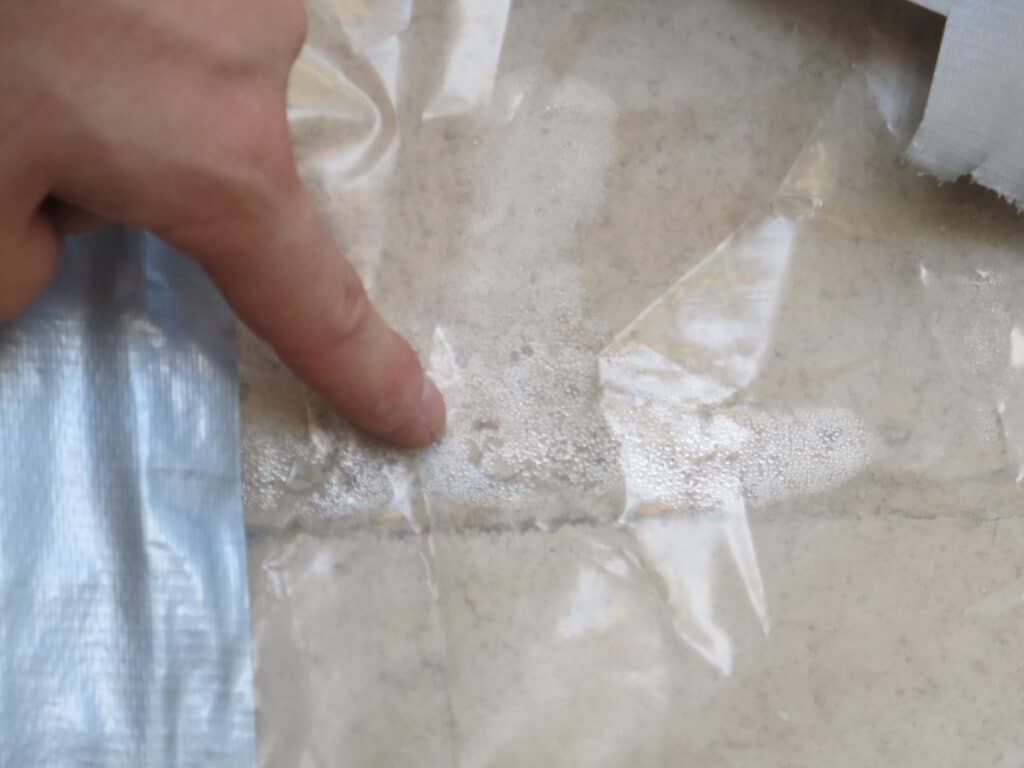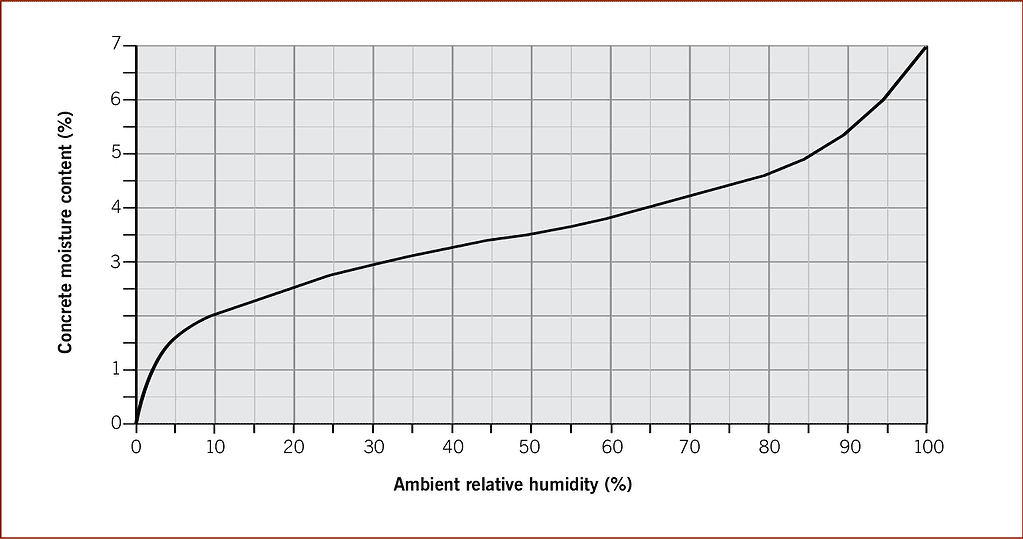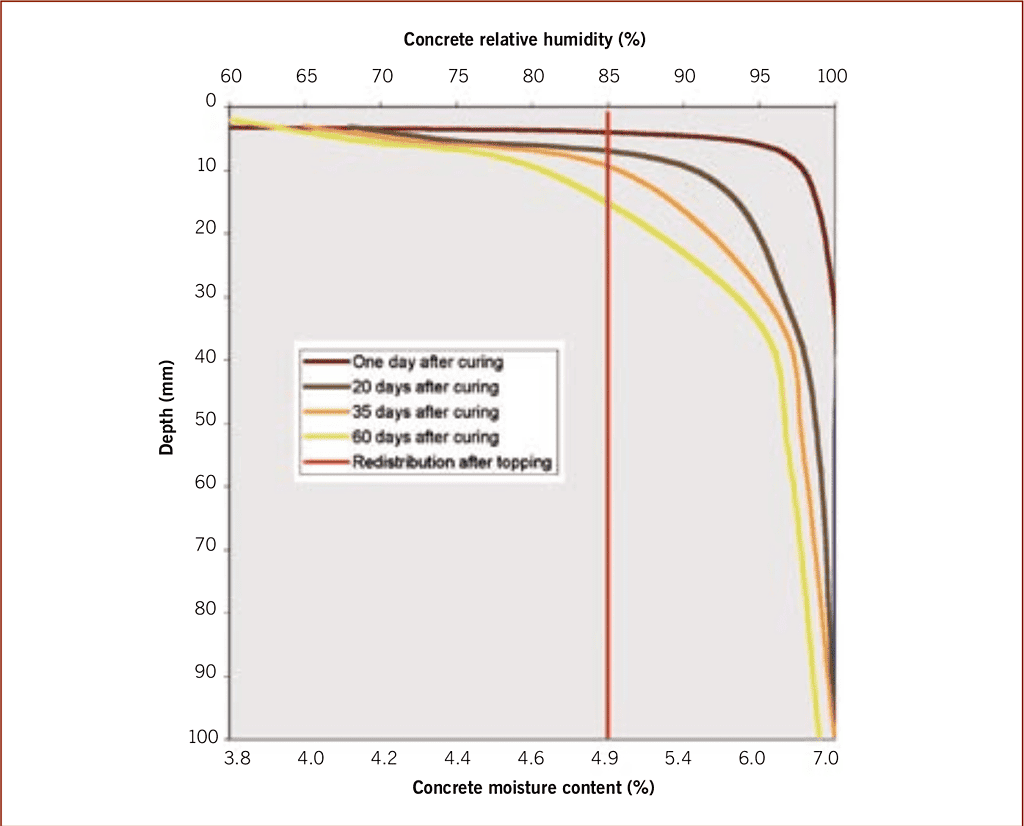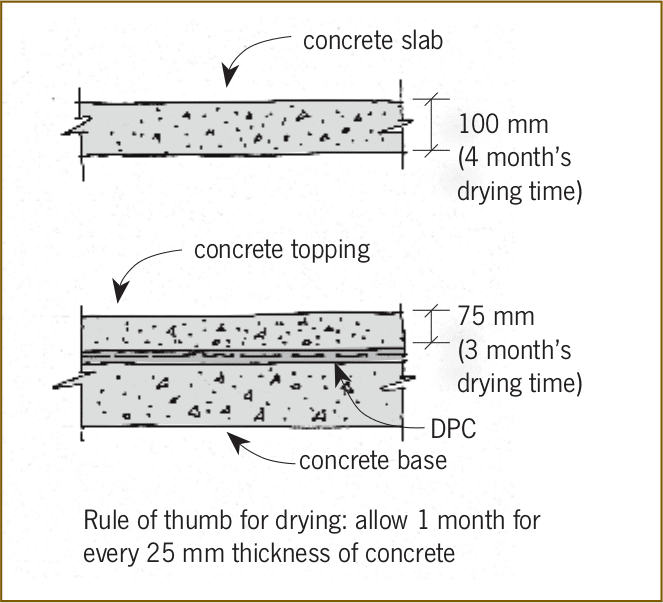When is concrete dry enough for coverings?
How to find out the moisture content of concrete? Fresh concrete contains significant water which evaporates over time. Installing floor coverings on the concrete slab before it’s dry enough is a way for disaster, so the question – how do you know if it’s dry enough?
Even a modest domestic floor slab may contain up to 260 gallons of excess water, added purely to allow the concrete to flow. This water is released as vapor through its top surface over time.
Installing a moisture-sensitive floor covering too soon will damage it. Wood and parquetry flooring can warp and cup, carpets can grow mold or rot, and low-permeability coverings, such as vinyl, can bubble and delaminate.
In fact, natural concrete slab drying will take a few months, and it’s important to ensure do not install floor coverings too early. In addition, the concrete shrinks, so it is critical to allow concrete to dry out enough before installing fixed floor coverings. But how dry is dry enough?
Concrete floor slab drying time
Assisting drying by closing in the slab to protect it from the rain and maintaining good ventilation. Fans to circulate air may be helpful but attempts to dry the concrete with heaters or dehumidifiers are generally unsuccessful. Moreover, such force-drying only affects the top few millimeters of the concrete, leading to misleadingly low moisture measurements.
As we already learn, a common drying time of a concrete slab will take several months. Under normal drying conditions, a rule of thumb allows at least one month of drying for every 1 inch of slab thickness after closing the building. For a 4-inch-thick slab, this means a minimum drying time of 4 months is necessary or maybe longer if there is:
- low air temperature
- high humidity
- poor ventilation because of airflow limitation across the slab
The construction schedule must allow for poor drying conditions. Forcing the drying time of concrete slabs using dehumidifiers or heaters is not a good choice. As it results in drying the top surface only – the moisture within the slab remains.
The number of floor-covering failures constantly growing in recent years. Mainly due to fast-track construction schedules and the reduction of more tolerant solvent-based flooring adhesives for environmental reasons.
How to measure slab drying
A flooring hygrometer is the most common tool to check moisture content or vapor transmission rate. This consists of a tensioned synthetic hair hygrometer and associated indicator dial mounted in an insulated PVC box.
As a matter of fact, hygrometers are convenient, quick, and cheap. Thus, it only gives useful results if the surface concrete is in equilibrium with the ambient building conditions. As an example, no force drying or recently subject to rain or washing.
| Floor-type | Hydrometer Reading | Humidity Probe Reading |
| Carpet | 70% | 85% |
| VCT | 70% | 90% |
| Wood | 65% | 80% |
Direct measurement of humidity at depth within the slab by inserting a probe. After drilling and sleeving hole gives a more accurate indication of the slab drying. This method is becoming increasingly popular as probes become available with integrated displays. Eliminating the need for ancillary data loggers to interpret the results.
However, unreliable correlation with absolute moisture conditions within the slab means they can’t rely on go/no-go decisions regarding floor covering installation.
American technical literature often references the anhydrous calcium chloride test. That uses a water-absorbent chemical on the concrete surface to measure vapor transmission rates in units of mass per area per day.
This method suffers from similar technical limitations to the flooring hygrometer. The additional problem is that it is a one-shot test that requires access to a sensitive balance to perform.
How to measure Moisture Content Of Concrete?
A concrete floor slab can have a maximum relative humidity of 75% before laying flooring when measured using a flooring hygrometer.
You can carry out a simple test of a slab’s moisture content by laying a 3 ft × 3 ft piece of clear polythene or rubber over the floor and taping down all edges. If there is condensation under the plastic after 24 hours, the slab is wet.

This quick test provides a rough indication only. If there is no condensation, use humidity probes or a hygrometer to carry out a more accurate measurement of concrete moisture content.
The accumulation of condensation is a sure sign that the slab needs to dry further. However, no moisture does not mean the slab is acceptably dry. Testing with a more sophisticated measurement technique is necessary to confirm this.
Allow time for on-site acclimatization
Once the slab is dry, timber and wood-based overlay flooring should acclimatize on site for at least 48 hours before installation. This will ensure that it is at the same temperature and moisture level as space where you plan installation.
It is necessary to open the flooring bundles and stack them off the substrate to allow air circulation around the material. It is also necessary to roll out the vinyl flooring and leave it for 48 hours to allow it to relax and the temperature to equalize with that of the space.
If these steps and the manufacturer’s instructions are followed, the results should be satisfactory and trouble-free fixed flooring laid over a concrete slab.
Concrete design can help to keep relative humidity
Where drying times are crucial, optimize the concrete mix design using low water-to-cement ratios with chemical admixtures providing the necessary plasticity. Furthermore, consider covering with polythene sheeting that will help to cure properly. This holds the mixing water without adding any extra moisture. You should avoid any curing compounds.
Moisture migration systems
Sometimes waiting for the slab to dry completely isn’t practical because of time constraints or a damaged or absent damp-proof membrane. Surface-applied moisture mitigation systems can reduce the vapor transmission rates to acceptable levels, but you should decide to rely on such a system carefully.
Always get the flooring supplier to write a warranty covering any damage to the floor if the system fails.
The most effective mitigation systems include purpose-designed epoxy coatings, which can cope with most vapor transmission rates. Non-emulsifying acrylics are generally restricted to solving less severe moisture problems and help isolate the applied flooring material from the pH rising effects of soluble alkalis leached from the concrete. Dense copolymer-modified cementitious overlays serve a similar function.
The least costly mitigation protections are often reactive penetrants based on potassium or sodium silicates. These work by chemically reacting with the calcium hydroxide in the concrete and forming additional cementing material that reduces surface porosity.
Achieving a successful result depends on many factors, including adequate concrete penetration, which normally necessitates shot-blasting of the surface. Conversely, an over-generous application can result in an unstable surface film. Consequently, it would be best if you used them with extreme caution for this purpose.

How to measure the moisture content of concrete
Three figures guide trade practice and appear regularly in TDS for deciding if it is safe to apply flooring over a new drying concrete slab – moisture content 5.5%, 15 g/m2/24 hours, and relative humidity 75%. What are these figures, and how can you use them?
First, you need to know how the moisture content of concrete changes as it dries. If, at some stage during drying, the concrete is overlayed or topped with a flooring material, then for weeks, the moisture reallocates itself until there is a uniform moisture profile through the concrete.
Second, we need the critical concept of a sorption curve. This shows the concrete moisture content will come to once all drying has stopped (its equilibrium value), given the relative humidity of the ambient air. The concrete is not in equilibrium while it’s drying. It is damp in the depths than on the surface and continuously changes until it has completely dried.
You can now understand the meaning of moisture content 5.5%, 15 g/m2/24 hours, and relative humidity 75% with these facts.
Maximum Moisture Content Of Concrete
This is a nominal value most product manufacturers specify when concrete is dry enough to allow their product to lay down on it. However, concrete with a moisture content of 5.5% is in equilibrium when the relative humidity of the ambient air is 90%. If the ambient relative humidity is lower, like, 60%, the equilibrium moisture content of concrete is also lower, at 3.9%.
As a matter of fact, at lower humidity, concrete with a 5.5% moisture content is still wet, and it has approximately 6.6 gallons per cubic meter more moisture to dry out of it.

The results? Only products that can tolerate high moisture content are good to use when using the trigger value of 5.5%.
Evaporation rate 15 g/m2/24 hours
No typical test method exists to confirm whether the concrete moisture content is below 5.5%. But because the rate of evaporation falls as concrete dries, the test method ASTM F1869-04 can work to measure this rate of evaporation.
If the evaporation rate is found to be below 15 g/m2/24 hours, it is usually taken as indicating that the concrete moisture content is below 5.5%.
The same warning applies if the evaporation rate measurement is 15 g/m2/24 hours. The concrete is still wet, and you can only use products that can withstand moisture content.
Moisture Content Of Concrete – Max relative humidity 75%
The figure of 75% relative humidity shows whether flooring, including gluing where necessary, can safely be undertaken. The sorption curve shows that 75% relative humidity is equivalent to an equilibrium moisture content of 4.4%.
This hygrometer reads the relative humidity in the top few millimeters of the concrete only. Figure 1 shows that if the relative humidity close to the surface of the concrete is 75%, it is still quite wet in its interior. Once topped, the moisture redistributes itself to a uniform moisture content that may be as high as 5% (85% relative humidity).
It is crucial to realize that if the slab has been force-dried (for example, with heating or dehumidification) or if the concrete has been rewetted, you can’t use a hydrometer with rain. It measures the surface relative humidity, which the force-drying will have reduced. In contrast, the concrete’s interior, which counts, has remained quite wet.
What can happen if the concrete slab still wet
Here are possible damages to flooring laid over a wet slab:
- lifting and swelling of wood coverings
- moisture bubbles under the vinyl and other resilient sheet floorings
- cracking of tiles due to concrete shrinkage
- under carpet condensation
- loss of adhesion for fully adhered flooring.

